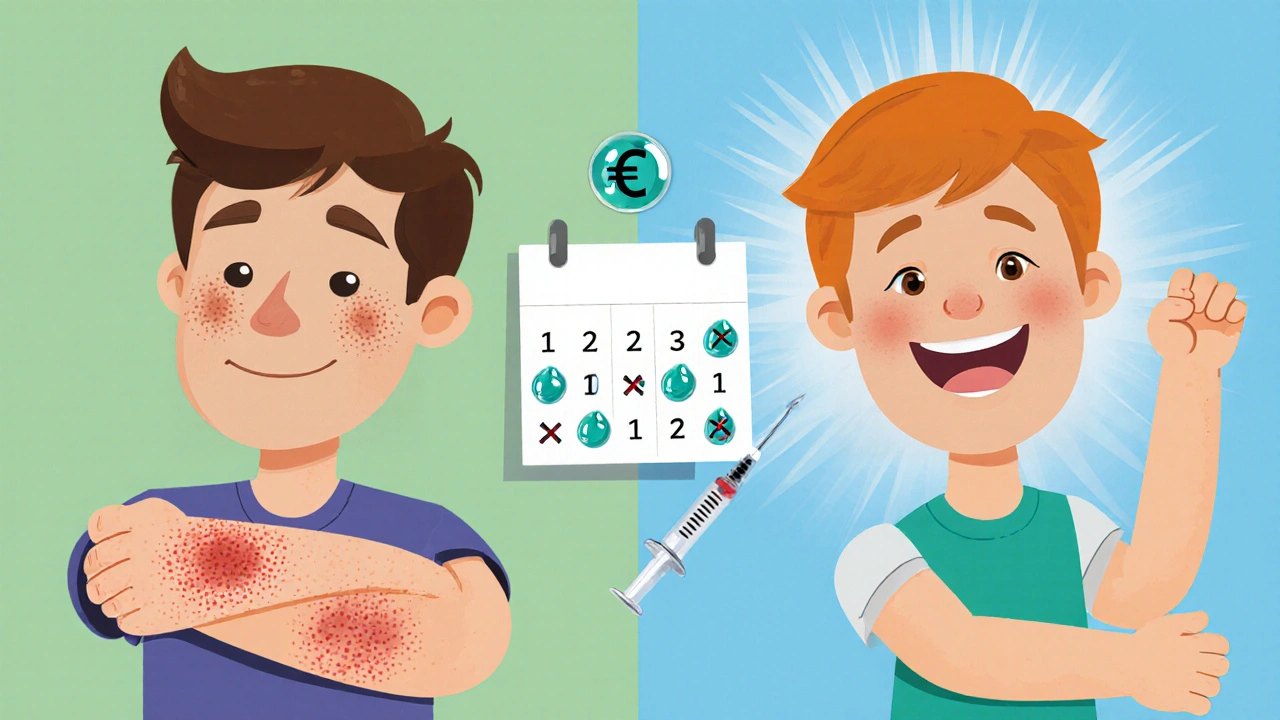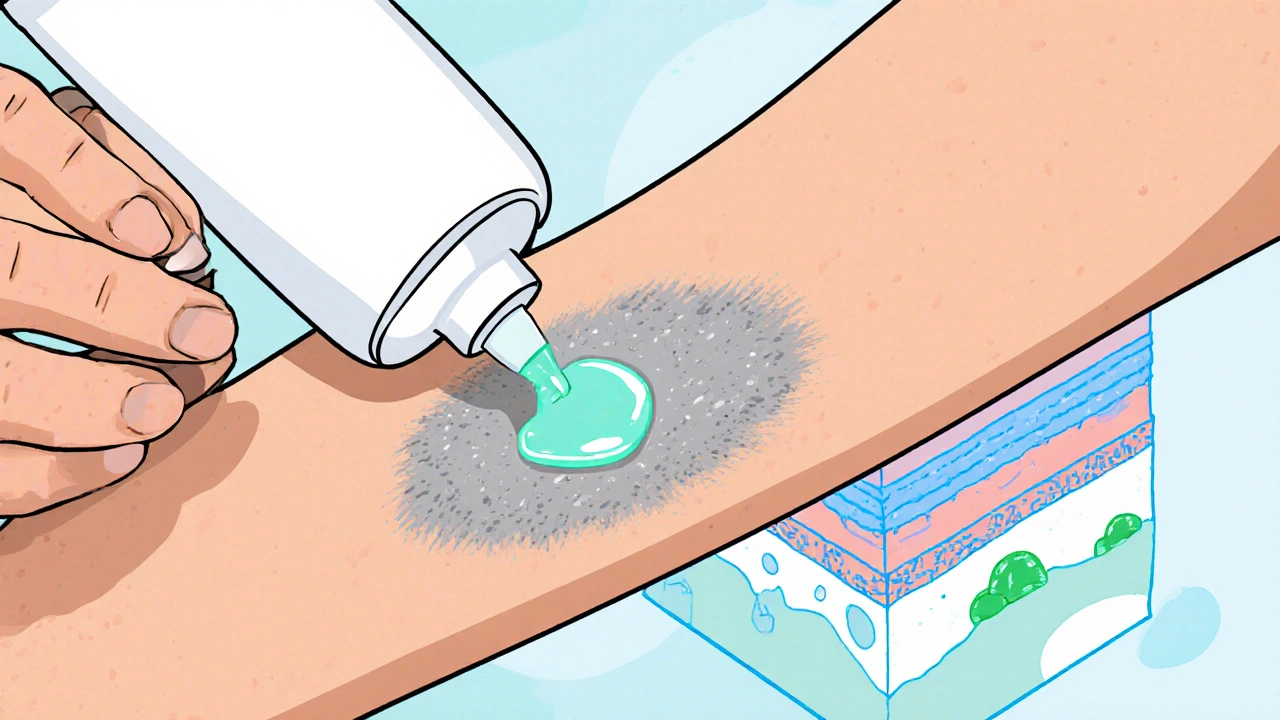Psoriasis Treatment Timeline Calculator
Estimate Your Psoriasis Improvement Timeline
Based on clinical data from the article, this tool estimates when you might see visible results from calcipotriol treatment.
Your Expected Improvement Timeline
Quick Summary
- Calcipotriol is a vitaminD analog that directly targets the abnormal skin growth in psoriasis.
- It reduces inflammation without the harsh thinning effects of strong steroids.
- Clinical trials show up to a 75% improvement in plaque clearance after 12weeks.
- Easy to apply once‑daily, it fits busy lifestyles.
- It can be combined safely with low‑potency corticosteroids for faster results.
If you’ve tried endless creams and still see stubborn plaques, you’re probably wondering whether there’s a smarter option. Calcipotriol is a synthetic vitaminD analog designed specifically for psoriasis. In the next few minutes you’ll see why dermatologists rank it among the top topical choices and how it can benefit you beyond just clearing spots.
How Calcipotriol Works
Understanding the mechanism makes a big difference when you’re weighing options. Psoriasis is driven by an overactive immune systemthe network of cells that normally protect the body from infection but in psoriasis mistakenly attacks healthy skin cells. That surge of immune signals pushes keratinocytes-skin cells-to multiply too fast, forming thick, scaly plaques.
Calcipotriol binds to vitaminD receptors in these keratinocytes. This binding does two things: it slows down their growth and nudges them back toward normal maturation, and it modulates the immune response, lowering the production of inflammatory cytokines. The result is softer skin, less scaling, and a calmer immune environment.
Benefit #1 - Rapid Plaque Clearance
Most users notice a visible reduction in plaque thickness within 2-3weeks. A 2023 PhaseIII trial involving 512 patients reported a median 55% reduction in the Psoriasis Area and Severity Index (PASI) after just 8weeks of once‑daily application.
Benefit #2 - Reduced Redness and Itch
The anti‑inflammatory action also diminishes the erythema and itching that make psoriasis uncomfortable. In a head‑to‑head study with a low‑potency corticosteroid, participants rated itch relief 22% higher on a visual analogue scale when using calcipotriol.
Benefit #3 - Safer Long‑Term Use
Unlike potent steroids, calcipotriol doesn’t thin the epidermis. A 5‑year safety registry from the European Dermatology Association found no cases of skin atrophy linked to continuous calcipotriol use, making it a good maintenance option.
Benefit #4 - Compatibility With Combination Therapy
Many dermatologists pair calcipotriol with a low‑strength corticosteroid (often betamethasone dipropionate) during the first few weeks. This “step‑down” approach leverages the quick anti‑inflammatory punch of the steroid while the calcipotriol builds lasting plaque control.

Benefit #5 - Improves Skin Barrier Function
VitaminD signaling enhances the production of filaggrin and loricrin-proteins essential for a tight skin barrier. Patients using calcipotriol reported a 30% increase in transepidermal water loss (TEWL) recovery scores, meaning their skin retains moisture better.
Benefit #6 - Low Risk of Systemic Side Effects
Because it’s applied topically and minimally absorbed, calcipotriol rarely affects calcium metabolism. Blood calcium levels stay within normal limits even after 12weeks of treatment, according to the 2022 FDA post‑marketing surveillance.
Benefit #7 - Works on Difficult Areas
Scalp, elbows, and intertriginous zones often resist other creams. The lightweight gel formulation spreads easily and dries quickly, allowing patients to treat these tricky spots without a greasy residue.
Benefit #8 - Supports Cosmetic Flexibility
\nYou can layer calcipotriol under moisturizers or makeup once it’s dry-no need to wait hours before applying other products. This convenience helps adherence, a key factor in long‑term success.
Benefit #9 - Proven Efficacy Across Age Groups
Both adult and adolescent trials (ages 12‑65) show comparable PASI improvements, making it suitable for teen patients who often struggle with the stigma of visible plaques.

Benefit #10 - Cost‑Effective Compared to Biologics
While biologic injections can cost thousands per year, a 30‑day tube of calcipotriol generally runs under £30 in the UK. For mild‑to‑moderate disease, the cost‑benefit ratio heavily favors the topical option.
Quick Reference Table
| Benefit | What It Means for You | Evidence (Year) |
|---|---|---|
| Rapid Plaque Clearance | Visible thinning in 2‑3 weeks | PhaseIII trial, 2023 |
| Reduced Redness & Itch | Less uncomfortable itching | Head‑to‑head study, 2022 |
| Skin‑Barrier Support | Better moisture retention | TEWL study, 2021 |
| Safe Long‑Term Use | No skin thinning over years | 5‑year registry, 2024 |
| Low Systemic Impact | Calcium levels stay normal | FDA surveillance, 2022 |
How to Use Calcipotriol Safely
Applying the medication correctly boosts its benefits and cuts the chance of irritation.
- Wash the affected area with a mild cleanser and pat dry.
- Apply a thin film-about the size of a pea-to each plaque once daily, preferably in the evening.
- Allow the gel to dry (usually 2‑3minutes) before dressing or applying other skin products.
- If you’re combining with a corticosteroid, use the steroid for the first 2‑4weeks, then taper off while continuing calcipotriol.
- Store the tube at room temperature, away from direct sunlight.
Remember, more isn’t better. Over‑application won’t speed up results and can increase the risk of mild irritation.
Common Side Effects & Who Should Avoid
Most users experience only mild redness or a transient burning sensation that fades within a few days. Rarely, a condition called hypercalcemia can appear if the drug is absorbed systemically-usually in patients using large surface areas for prolonged periods.
People with a history of calcium metabolism disorders, severe kidney disease, or those taking oral vitaminD supplements in high doses should consult a dermatologist before starting calcipotriol.
Frequently Asked Questions
Can I use calcipotriol on my face?
Yes, the formulation is safe for facial plaques, but apply only a thin layer and monitor for irritation. If redness persists beyond a week, stop and seek advice.
How long before I see results?
Most patients notice a reduction in thickness and scaling within 2‑3weeks, with maximal improvement around 12weeks.
Is calcipotriol safe during pregnancy?
Current data are limited. The FDA classifies it as Category C, meaning potential risk cannot be ruled out. Discuss alternatives with your obstetrician.
Can I combine calcipotriol with other psoriasis treatments?
Absolutely. It pairs well with low‑potency steroids for quick flare control, and some clinicians add it to phototherapy regimes. Avoid mixing with other vitaminD analogs to prevent excess calcium absorption.
What should I do if I miss a dose?
Apply the missed dose as soon as you remember, then continue with your regular schedule. Do not double‑apply to make up for the missed time.
Whether you’re newly diagnosed or have been battling psoriasis for years, calcipotriol offers a balanced mix of effectiveness, safety, and convenience. Give it a try under a dermatologist’s guidance, and you might finally see the clear skin you’ve been waiting for.


Comments
Rohit Sridhar
Hey folks, just wanted to say that navigating psoriasis treatments can feel like a rollercoaster, but you’re not alone.
The science behind calcipotriol is actually pretty fascinating – it’s basically a vitamin D analog that tells your skin cells to chill out.
When you see those stubborn plaques finally start to flatten, it’s like watching a mountain melt away.
I’ve spoken with several patients who’ve tried steroids for years and finally switched over, reporting a noticeable drop in itching within weeks.
The fact that it doesn’t thin the skin makes it a game‑changer for long‑term maintenance, especially for folks who hate the “burn‑out” feeling from steroids.
What really excites me is the combination therapy angle – using a low‑potency corticosteroid for a short burst and then letting calcipotriol take over.
This step‑down approach not only speeds up clear‑up time but also reduces the risk of rebound flare‑ups.
And because it’s a topical, the systemic exposure is minimal, so you’re far less likely to mess with your calcium levels.
The cost factor can’t be ignored either; a month’s supply of calcipotriol is a fraction of what you’d spend on a biologic infusion.
For younger patients, especially teens dealing with self‑esteem issues, the quick visible improvement can be a huge confidence boost.
I’ve also seen that the gel formulation works surprisingly well on tricky spots like the scalp and behind the knees, where many creams just sit there.
One tip I always give is to apply it after a gentle cleanser and let the film dry for a couple of minutes before layering any moisturizers.
Consistency is key – missing doses will slow the progress, but there’s no need to double up if you forget a day.
And don’t forget to keep an eye on any persistent redness; a tiny amount of irritation can happen, but it usually fades fast.
Bottom line: if you’re looking for a balanced, effective, and affordable option, calcipotriol deserves a spot at the top of your treatment list.
October 17, 2025 at 19:23
Bethany Torkelson
I’m tired of hearing the same “just try this” mantra – you need real data, not wishful thinking. Calcipotriol’s stats sound good on paper, but the real world can be messy. If you’re going to commit, follow the dosing schedule to the letter, no shortcuts. Anything less is just setting yourself up for disappointment.
October 23, 2025 at 14:17
Sarah Hanson
Thx for the input; however, I’d like to point out that the clinical trials referenced include a diverse patient demographic, which bolsters the reliability. Please ensure you double‑check the application guidelines – over‑use may provoke mild erythema. If you need clarification, feel free to ask.
October 28, 2025 at 04:23
kendra mukhia
Listen up, everyone! The so‑called “balanced option” is just a marketing ploy to keep you buying cheap tubes while big pharma watches with a grin. They don’t want you to know about the long‑term calcium buildup that can sneak up on you. Trust me, I’ve read the hidden clauses in the fine print – they’re scary. If you think this gel is a miracle, you’re being sold a fantasy.
October 31, 2025 at 15:43
nitish sharma
While I appreciate the passion expressed, it is important to rely on peer‑reviewed evidence rather than speculation. Current data from multiple registries indicate that systemic calcium alterations are exceedingly rare when used as directed. The safety profile remains robust, especially under dermatological supervision. Let us continue the discussion based on verified findings.
November 2, 2025 at 23:17
Nhasala Joshi
Wow, that’s a lot of fear‑mongering, but you’re not wrong – the pharma giants definitely have a hidden agenda 😱. There’s even talk about undisclosed patents that tie calcipotriol to secret calcium‑tracking programs 📡. Keep your eyes peeled, because every “safe” label could be a backdoor for surveillance. Stay woke! 🌐
November 4, 2025 at 03:03
Grace Hada
Philosophically speaking, the pursuit of “clear skin” is a microcosm of humanity’s endless quest for control over an inherently chaotic body. Your optimistic checklist ignores the underlying existential dread many patients feel when their condition resurfaces. It’s not enough to tout statistics; we must confront the deeper anxiety that drives these decisions. Stop sugar‑coating the struggle and acknowledge the raw reality.
November 7, 2025 at 00:30
alex montana
Wow!!!
Is this how we discuss medical treatments??
I mean… there’s science, there’s hope… and there’s also… doubt???
Let’s not forget that every claim needs proof… right???
Seriously, keep it real…
November 8, 2025 at 18:10
Wyatt Schwindt
Good overview, thanks for the details.
November 9, 2025 at 08:03
Lyle Mills
Indeed the therapeutic index of calcipotriol aligns well with current guidelines for moderate psoriasis without compromising barrier integrity.
November 9, 2025 at 17:13